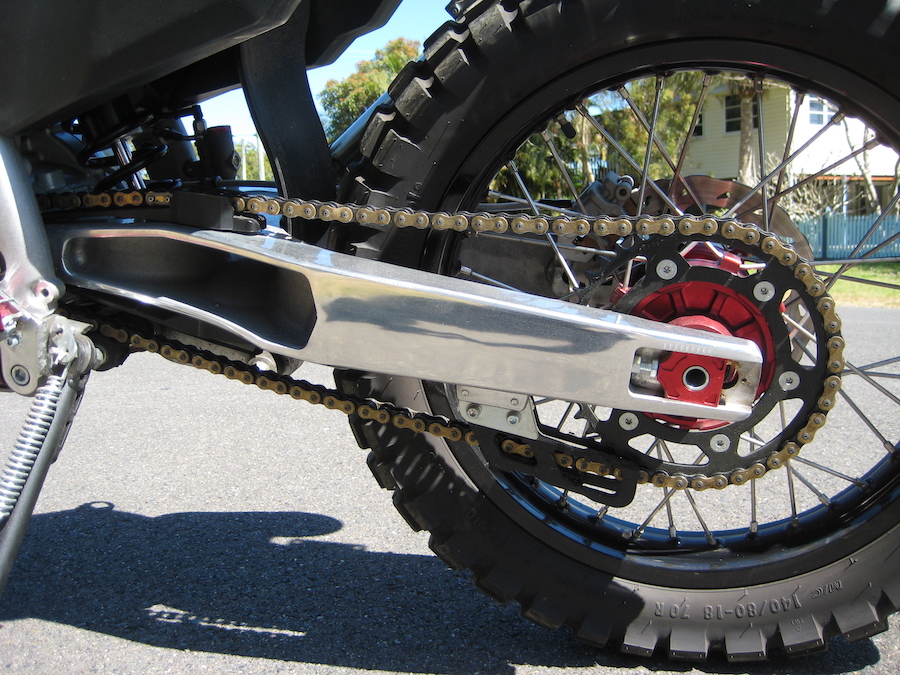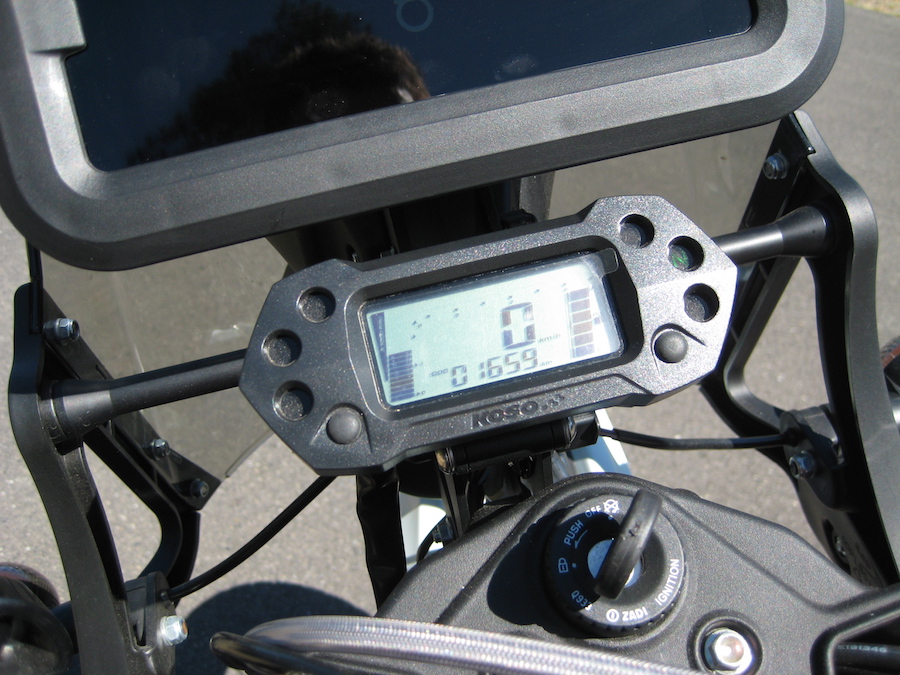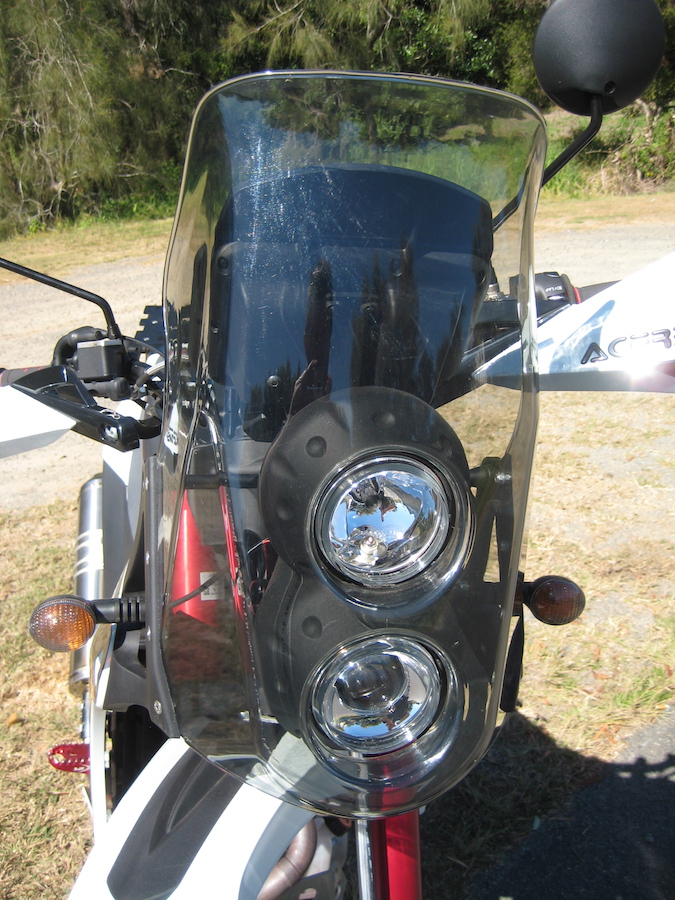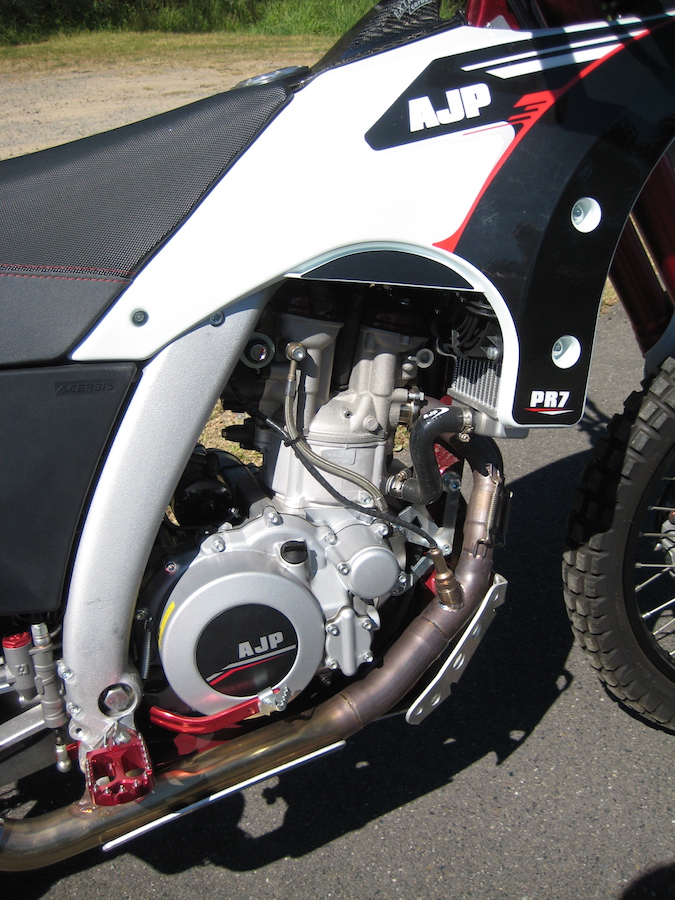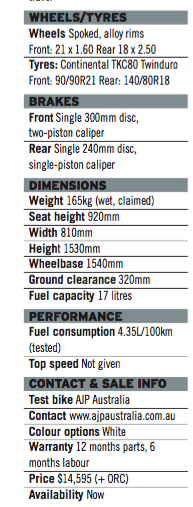A little-known Portuguese brand plugs a gaping hole in the adventure bike market with a rally raid-inspired marvel
Just like their riders, adventure bikes come in all shapes and sizes, from barnstorming behemoths made famous by the likes of Charley and Ewan to pint-size entry-level offerings such as the BMW G310GS and Kawasaki Versys X-300.
But which type of bike is the ‘just right’ ADV machine? That’s the $64,000 question and one that promotes endless banter in the bars popular with ADV riders, from the edge of the Simpson Desert to the top of the Victorian High Country. You will just never get everyone to agree.

Given adventure bikes have been flavour of the month with manufacturers in recent years, when one pops up that comes from a little out of left field, it’s sure to have the spotlight shone on it. And that was precisely the case when the AJP PR7 was first unveiled in late 2014 at the Intermot Show in Germany.
Now, if you find yourself asking, ‘A-J-who? P-R- what?’, don’t feel bad, because you wouldn’t be the only one.
AJP is a Portuguese brand, best known for producing a range of small-capacity four-stroke off-road bikes sold in various markets around the world, including Australia. The PR7, however, breaks new ground by being a big-bore thumper with a clearly rally-inspired design brief, aimed fair and square at off-road-biased adventure riders. Yes, many an Aussie ADVer’s ears just pricked up.
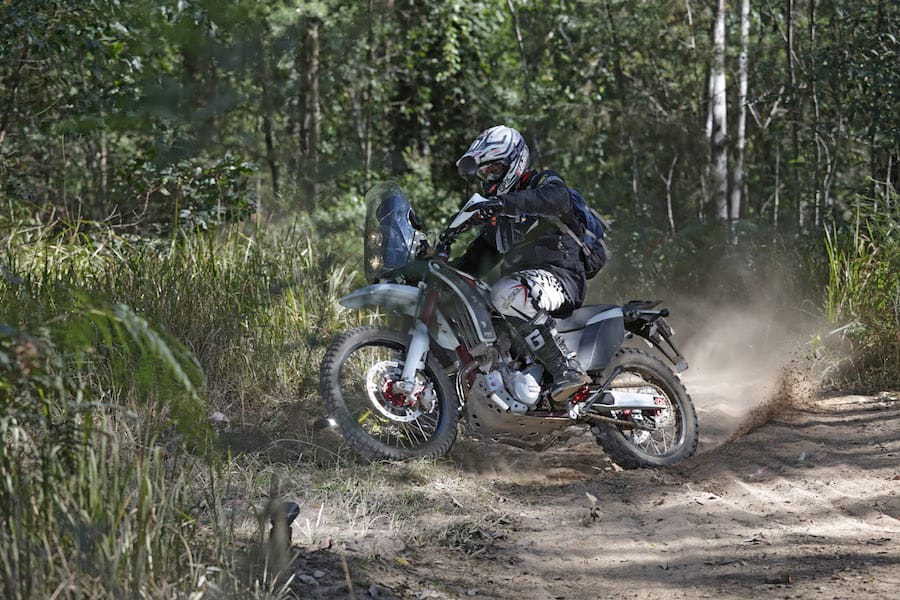
The best part of three years after that show preview, the PR7 is now a production reality and recently went on sale in Australia via a fledgling network of dealers under the umbrella of Gold Coast-based distributor AJP Australia.
In an era when many show bikes ultimately end up being dumbed down or priced down by the time they reach production, the PR7 has remained true to brief and, as it now sits on showroom floors, remains very much a rally-inspired, lightweight and purposeful single-cylinder adventure machine. In fact, the PR7 production model has arguably been improved over the show bike because the original 660cc Minarelli powerplant has been replaced by a lighter and more powerful 600cc engine from SWM. This motor, which also powers the SWM Superdual and RS650 trail bike, is a direct descendent of the much-loved Husqvarna TE630 motor.
The fuel-injected DOHC single is fed by a 45mm throttle body, is equipped with a balancer shaft and drives through a six-speed gearbox with hydraulic clutch actuation. AJP claims the engine, which is Euro 4 compliant and LAMS approved, puts out 36.5kW.
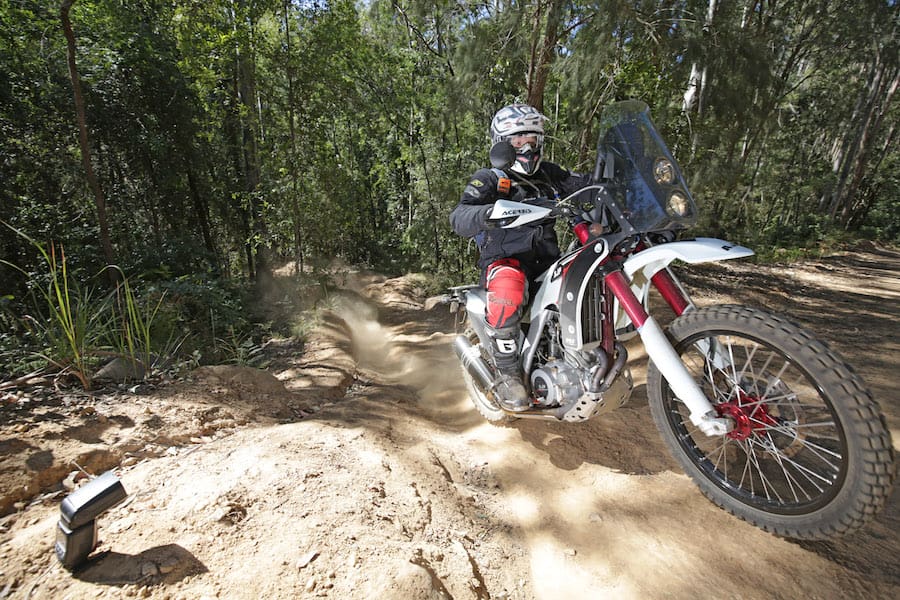
While the engine has been changed and the Marzocchi fork and Öhlins shock have been replaced by ZF Sachs components, the PR7 is otherwise very similar to the 2014 show bike.
AJP’s trademark hybrid twin-spar steel and aluminium frame is mated with another trademark feature of the Portuguese brand, an under-seat fuel cell. The tank is made by Acerbis and carries 17 litres of go-juice, with the lockable filler cap moved to a more practical location at the front of the seat rather than at the rear, as it was on the show bike.
Also continuing through to production is the steering head-mounted navigation tower and rally-replica screen, which houses twin stacked headlights and protects an ASUS android tablet that owners can load with nav and speedo/tripmeter apps. A traditional but small LCD display that features speedo, tacho, trip and fuel gauge info is also fitted, below the tablet. Reikon alloy bars, Acerbis full-wrap handguards and Domino grips complete the flight deck.
A long and roomy seat offers very slim ergos between the knees, with the lockable fuel cap and carbon airbox lid housing a K&N-style filter element, mounted directly in front of the seat. The engine breathes out through twin titanium header pipes, which sweep down rally-style in a single mid-pipe along the right side of the engine cases and lower frame cradle before joining an upswept muffler mounted below the right side of the fuel cell. The exhaust, engine cases and lower frame rails are well protected by an alloy bashplate.
Wheels are 21-inch front and 18-inch rear fitted with TKC Twinduro rubber. Black rims are laced up to red anodised hubs, the red touch carrying over to the 48mm USD fork’s outer tubes, lower frame cradle, rear brake pedal and beefy footpegs. Front wheel travel is a healthy 300mm and rear wheel travel is 280mm, with both the fork and shock offering a myriad of compression and rebound damping adjustment. A big 300mm rotor and dual-piston caliper handle the braking up front, while out back is a 240mm rotor and single-piston caliper. A rear rack is also included in the package, which bolts up to the bike’s rear subframe – and, yes, there is a subframe, concealed within the fuel tank’s mouldings.
The PR7 has a wheelbase of 1540mm, seat height of 920mm and ground clearance of 320mm. However, the big – or should we say, little – number is the PR7’s weight: 140kg dry, or 165kg wet with a full load of fuel and all fluids. By comparison, Honda puts the wet weight of the CRF250 Rally at 157kg while Yamaha’s XT660Z Tenere tips the scales at 209kg wet.
The PR7 is priced at $14,595 plus on-roads and is backed by a warranty of 12 months on parts and six months for labour.
If you have a desire for a lightweight, high-performance, rally-inspired adventure machine, the preceding information will certainly have piqued your curiosity. But how does the PR7 work in the dirt? This is precisely what we were itching to find out when we were handed the keys at Coffs Harbour on the NSW north coast and allowed to ride it back to Sydney.
As far as first impressions go, the PR7 scores solid points, with the bike’s componentry and build quality looking fine. Throwing a leg over it, the ergos feel good right away, the slim seat/airbox junction is thin, the seat is easy to move fore and aft, the ’pegs offer a great platform to stand on, and the ’bars are wide with a neutral bend, though just a slight boost in rise will better accommodate taller riders.
Firing the button, the Italian-made engine soon settles down to idle, the exhaust note noticeably quiet, with more induction noise apparent from the airbox lid. The hydraulic clutch action is light and easy and the gearbox shifts easily on the first stint down the highway, the screen pushing just enough wind blast away from the rider to make transport sections comfortable enough. An indicated 110km/h is easily lapped up by the six-speed transmission, which runs tall 15/42 final gearing and is therefore ticking over at an almost vibe-free 5000rpm, with plenty more to offer.
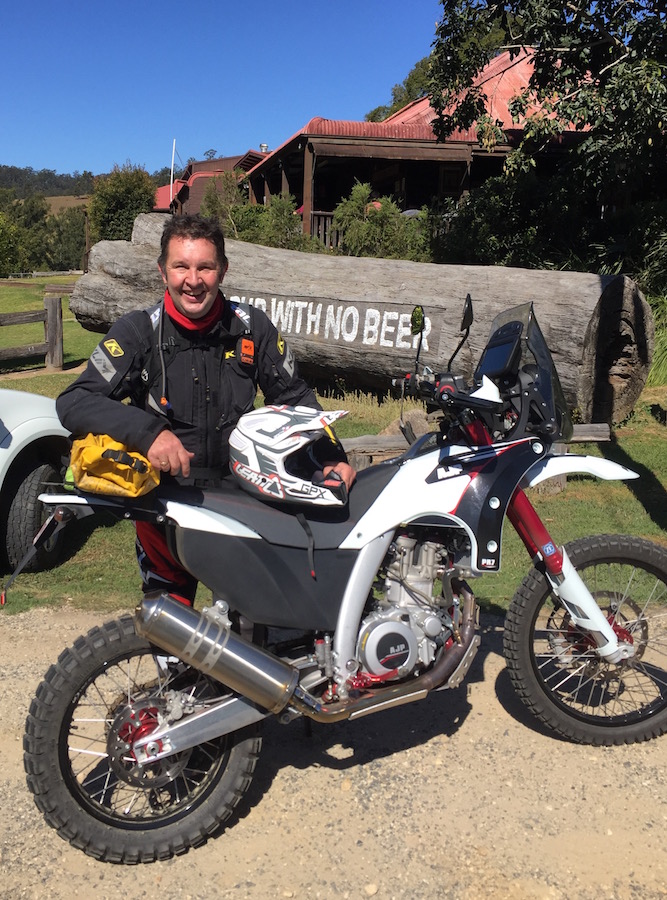
Heading towards Taylors Arm and the famed Pub With No Beer, we reach tight and twisty white gravel roads and right away discover that the AJP rides best when ridden like a dirtbike. That means standing up and getting your body weight over the front end to give the front tyre as much bite as possible. The power delivery is clean and strong and the bike drives solidly out of turns, although you can’t help but feel the engine could do with more ponies. Slightly lower gearing could also boost acceleration, but so too would the optional Power-Up kit offered by AJP, which includes a remapped ECU and freer breathing airbox lid and exhaust. It’s a $1500 kit, but the added oomph would clearly help the PR7.
Trekking further west, sections of fire-trail and forest tracks quickly bring the PR7’s off-road pedigree to the fore. The fork and shock action borders on the firm side in the initial part of the travel, certainly with sharp-edged hits, so backing off the clickers on the fork helps here. On bigger obstacles, like erosion humps and G-outs, the suspension really impresses, and the stable handling package helps to keep the PR7 on line and powering.
The slim ergos, open cockpit, strong brakes and the bike’s light weight, with that fuel load carried low, let you ride the PR7 just like a dirtbike, and you soon realise there’s absolutely nowhere you couldn’t take this bike in the bush. If you drop it you’ll be able to easily pick it up again, and if you cop a blocked route, turning it around again will be a simple task.
After six hours and 271km of solid riding, the PR7 takes 12.88 litres to fill the tank (equating to 4.8L/100km) and we bunk down on the coast just south of Port Macquarie.
The next day promises to be a big one. The plan is a sunrise-to-sunset agenda that dishes up more than 600km of top-shelf adventure riding, including large tracts of the upper Hunter Valley, Barrington Tops and the Watagan forests, before winding up with a motorway romp back into the big smoke. Talk about an ADV all-you-can-eat buffet – and the PR7 feasts on the lot.
Of course the PR7’s forte is in the dirt, but a big day like this shows it will do it all. It can drone through the tarmac transports readily before coming to life when you hit the dirt, even more so when the dirt gets tight and technical by ADV standards. After 620km for the day, we both pull up fine with that long saddle proving a beauty and the screen cutting down the buffeting. Economy comes in as low as 4.2L/100km, suggesting a range for the 17 litre tank of 350km or more.
It should be noted that the engine likes to be in neutral to fire up readily, while the stock lithium battery had been replaced by a lead-acid unit on the test bike for improved cold winter morning starts. As for the ASUS tablet, it’s a bonus if you’re tech savvy and want to explore navigation and speedo/trip info apps. Or you can remove it and mount your traditional GPS in the space.

As the sum of its parts, the PR7 is clearly off road-biased and cuts another niche in the ever-widening ADV landscape – the niche of the true rally replica, precisely the kind of machine dirt-oriented Aussie adventurers have long been waiting for. But this is not a rally replica powered by a highly strung race-bred 450cc powerplant, rather a big-bore thumper with a reputation for reliability and performance.
Not since the revered KTM 640 Adventure, which was pensioned off almost a decade ago, has any brand delivered a bike precisely like this, with serious off-road chops, wind protection and long-distance fuel capacity.
Many bike makers have poured massive dollars into the annual Dakar Rally, yet few have capitalised by putting a true production rally replica ADV machine on the showroom floor – the exceptions being Honda with its soft-core lookalike CRF250 Rally, and KTM/Husqvarna with their limited-run and mega-dollar RR rally racebikes.
Instead, it’s taken a little-known Portuguese brand to plug an obvious hole in the market with a bike that has been the dream of hard-core adventure riders, who want to travel light and ride hard and fast and seriously off road.
TEST ANDREW CLUBB
PHOTOGRAPHY MITCH LEES

